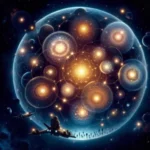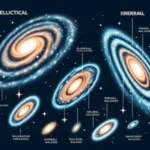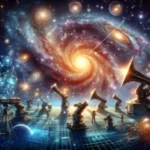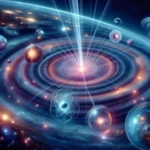The vast expanse of the cosmos has long captivated human curiosity, with its twinkling stars and enigmatic galaxies inviting us to ponder our place in the universe.
But beyond the sheer wonder lies a profound question that has intrigued astronomers for centuries: how old is the universe? Determining the age of the cosmos is no easy feat, as it involves complex calculations, cutting-edge technology, and a deep understanding of astrophysical principles. From analyzing the oldest known star clusters to measuring the cosmic microwave background radiation left over from the Big Bang, scientists have developed innovative methods to peel back the layers of time and reveal the universe’s history. In this blog post, we will embark on a journey through the cosmos, exploring the techniques and discoveries that have shaped our understanding of the universe’s age and the intricate story it tells about the birth and evolution of everything we know. Join us as we unravel the mysteries of the cosmos and uncover the timeline of our magnificent universe!
1. Introduction: The Quest to Understand the Universe’s Age
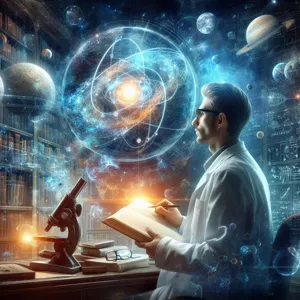
The quest to understand the age of the universe is one of the most profound and captivating endeavors in the realm of astronomy. Humanity has gazed at the night sky for millennia, pondering the mysteries of the stars and the vastness of space. As our technology advanced, so too did our understanding of the cosmos, leading us to seek answers to fundamental questions: How old is the universe? When did it begin? What events have shaped its evolution?
At the heart of this quest lies a tapestry of intricate measurements and theoretical models, each woven together to create a comprehensive picture of the universe’s timeline. From the ancient stargazers who mapped constellations to the sophisticated telescopes of today that peer deep into the cosmos, astronomers have employed a multitude of methods to unravel the age of the universe. These include the study of celestial objects, cosmic microwave background radiation, and the expansion of galaxies, each offering unique insights into the universe’s beginnings.
In this exploration, we will delve into the key techniques used by astronomers to estimate the universe’s age, examining how these methods interconnect and the implications they hold for our understanding of existence itself. Join us on this enlightening journey as we unravel the cosmos and uncover the timeline that has brought us to our present moment in the grand tapestry of the universe.
2. The Big Bang Theory: A Foundation for Cosmic Age
The Big Bang Theory serves as the cornerstone of our understanding of the universe’s origins and provides a framework for determining its age. Proposed in the early 20th century, this theory posits that the universe began as an infinitely dense and hot point, known as a singularity, approximately 13.8 billion years ago. This monumental event marked the inception of space and time, as well as the expansion of the universe itself.
Astronomers gather compelling evidence for the Big Bang through a variety of observations. One of the most crucial pieces of data comes from the cosmic microwave background radiation (CMB), which is the afterglow of the initial explosion. Discovered in the 1960s, the CMB is a faint, uniform glow that permeates the universe, serving as a relic of its hot, dense beginnings. By studying the temperature fluctuations and patterns within this radiation, scientists can glean insights into the conditions of the early universe, leading to estimations of its age.
Moreover, the expansion of the universe, a phenomenon first observed by Edwin Hubble in the 1920s, provides further validation of the Big Bang Theory. By measuring the redshift of distant galaxies—an effect caused by their movement away from us—astronomers can calculate the rate of expansion, known as the Hubble constant. This rate, when applied to the distance of galaxies from Earth, allows researchers to backtrack to the moment of the Big Bang, creating a timeline of cosmic history.
In essence, the Big Bang Theory not only explains how the universe began but also acts as a vital tool for astronomers in their quest to unravel the cosmos. It allows them to piece together the timeline of our universe, leading to a better understanding of its age and the intricate processes that have shaped its evolution over billions of years.
3. Key Concepts in Cosmology

To truly grasp how astronomers determine the age of the universe, it’s essential to familiarize ourselves with several key concepts in cosmology. These foundational ideas serve as the building blocks of our understanding of the cosmos and the intricate processes that govern it.
**1. The Big Bang Theory:** At the heart of modern cosmology lies the Big Bang Theory, which posits that the universe began as a singular, infinitely dense point approximately 13.8 billion years ago. This colossal explosion initiated the rapid expansion of space, leading to the formation of galaxies, stars, and ultimately the complex structures we observe today. Understanding this event is crucial, as it provides the starting point from which astronomers measure the universe’s age.
**2. Cosmic Microwave Background Radiation (CMB):** One of the most significant pieces of evidence supporting the Big Bang Theory is the Cosmic Microwave Background Radiation. This faint glow, detected in every direction of the universe, is a remnant of the heat left over from the early universe. By studying the CMB’s temperature fluctuations, astronomers can glean insights into the universe’s composition, its rate of expansion, and its age.
**3. Hubble’s Law:** Named after the astronomer Edwin Hubble, this principle states that the farther away a galaxy is, the faster it is receding from us. This observation led to the realization that the universe is still expanding, which is a critical factor in calculating its age. By measuring the redshift of distant galaxies—how their light shifts toward the red end of the spectrum due to their speed—astronomers can estimate how long the universe has been expanding.
**4. Stellar Evolution:** Understanding the life cycles of stars also plays a pivotal role in age determination. By examining the brightness and temperature of stars, astronomers can determine their stage in the evolutionary process. The oldest stars, found in globular clusters, provide a minimum age for the universe, as they formed shortly after the Big Bang.
**5. Dark Energy and the Universe’s Fate:** Lastly, the concept of dark energy—an enigmatic force driving the accelerated expansion of the universe—has become increasingly important in cosmological studies. This mysterious energy influences how we interpret the expansion history of the universe, affecting calculations related to its age.
Together, these key concepts form a framework that enables astronomers to unravel the mysteries of the universe’s age. By combining observational data with theoretical models, they piece together a timeline of cosmic history that continues to evolve as new discoveries are made. Understanding these principles not only sheds light on our universe’s past but also sparks curiosity about what lies ahead in the vast, uncharted cosmos.
4. Methods of Measuring the Universe’s Age
Determining the age of the universe is a complex task that employs various methods, each offering unique insights into the cosmos’ timeline. At the forefront of these methods is the study of cosmic microwave background radiation, the faint afterglow of the Big Bang. By measuring the temperature fluctuations in this radiation, astronomers can infer the conditions of the early universe, leading to estimates of its age. This pivotal work has provided a cornerstone for our understanding, suggesting that the universe is approximately 13.8 billion years old.
Another crucial method involves the observation of distant stars and galaxies. Astronomers utilize the concept of stellar evolution, tracking the life cycles of stars from their formation to their eventual demise. By identifying the oldest known star clusters, particularly globular clusters, researchers can estimate the minimum age of the universe. These ancient stars, some of which are nearly as old as the universe itself, act as time capsules, offering a glimpse into the cosmos’ early history.
Additionally, the expansion of the universe plays a significant role in age estimation. Edwin Hubble’s discovery of the redshift phenomenon demonstrated that galaxies are moving away from us, suggesting that the universe is expanding. By measuring the rate of this expansion—known as the Hubble constant—scientists can extrapolate backwards to determine when the universe was concentrated into a singular point, effectively calculating its age.
Lastly, the study of nucleocosmochronology, which examines the abundance of certain radioactive isotopes in ancient stars, provides yet another layer to the puzzle. This method allows astronomers to date the formation of heavy elements, further refining our understanding of the timeline of cosmic events.
Through these diverse methodologies, astronomers weave together a comprehensive narrative of the universe’s history, illuminating not just its age but also the intricate processes that have shaped the cosmos over billions of years. Each method serves as a unique thread in the tapestry of cosmic exploration, revealing the profound story of our universe’s birth and evolution.
5. The Role of Light and Distance: Understanding Redshift
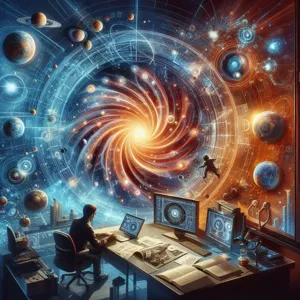
Understanding the age of the universe requires delving into the intricate relationship between light, distance, and the phenomenon known as redshift. When we look up at the night sky, we aren’t merely gazing into a vast expanse of darkness; we’re observing a tapestry of light that carries with it the secrets of cosmic history. Light travels at an incredible speed, but even at this remarkable velocity, it takes time to traverse the immense distances that separate celestial bodies. In essence, when we observe distant galaxies, we are not seeing them as they are in the present moment, but rather as they were in the past.
This is where redshift comes into play. As the universe expands, the light emitted by distant galaxies stretches, shifting toward the red end of the spectrum. This redshift is a crucial indicator of how fast a galaxy is moving away from us, a phenomenon that Edwin Hubble famously quantified in the early 20th century. The greater the redshift, the faster the galaxy is receding, and, by extension, the farther away it is. By measuring this redshift, astronomers can estimate not only the distance to these galaxies but also infer their speed relative to Earth, providing insights into the rate of the universe’s expansion.
The implications of redshift are profound. It allows astronomers to construct a timeline of cosmic events, tracing back the evolution of galaxies over billions of years. By understanding the relationship between distance and redshift, scientists can also estimate the age of the universe itself. Current models suggest that the universe is approximately 13.8 billion years old, a figure derived from meticulous observations and calculations involving redshift data.
In summary, redshift serves as a cosmic time machine, enabling astronomers to peel back the layers of time and uncover the history of our universe. By studying the light from distant galaxies, we not only grasp their origins but also gain a deeper understanding of the very nature of space and time itself. As we unravel the cosmos, it becomes evident that light is not just a simple wave or particle; it is a messenger of the universe’s past, guiding us on our quest to understand our place within it.
6. Cosmic Microwave Background Radiation: A Fossil of the Early Universe
The Cosmic Microwave Background Radiation (CMB) serves as a remarkable relic of the early universe, offering astronomers a glimpse into its infancy just moments after the Big Bang. This faint glow, permeating every corner of the cosmos, is a remnant of the hot, dense state that our universe emerged from approximately 13.8 billion years ago.
Imagine the universe as a vast, dark room slowly filling with a warm, soft light. The CMB is that whisper of warmth, a cosmic echo that has traveled through space and time, cooling and stretching as the universe expanded. It was first detected in 1965 by Arno Penzias and Robert Wilson, a discovery that would ultimately earn them the Nobel Prize. The significance of the CMB lies not just in its existence but in the information it holds about the universe’s formation and evolution.
The CMB is a nearly uniform background radiation that can be observed in all directions, revealing tiny fluctuations in temperature. These fluctuations, mere millionths of a degree, are key to understanding the density variations in the early universe—essentially the seeds of all structure we see today, from galaxies to galaxy clusters. By analyzing the CMB’s temperature fluctuations, astronomers can glean insights into the universe’s composition, expansion rate, and, crucially, its age.
Advanced missions like the Wilkinson Microwave Anisotropy Probe (WMAP) and the Planck satellite have provided high-resolution maps of the CMB, allowing scientists to refine their estimates of the universe’s age. These measurements contribute to the broader cosmological model, helping us unravel the complex tapestry of cosmic history. In essence, the CMB is not just background noise; it is a cosmic fingerprint that continues to illuminate our understanding of the universe’s origins and its vast, unfolding story.
7. The Importance of Stellar Evolution in Age Determination
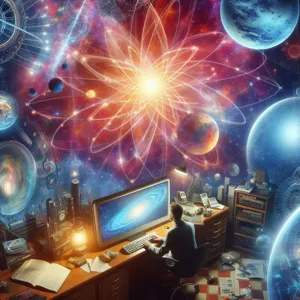
Stellar evolution plays a crucial role in our understanding of the age of the universe, acting as a cosmic clock that helps astronomers unravel the mysteries of time itself. Each star goes through a life cycle, from its birth in nebulae to its eventual demise, and these stages are governed by the star’s mass and composition. By studying different types of stars at various points in their life cycles, astronomers can glean insights into the age of not only individual stars but also the galaxies they inhabit.
One of the key aspects of stellar evolution is the Hertzsprung-Russell diagram, a graphical representation that plots stars according to their luminosity and temperature. This diagram reveals distinct regions where stars of similar ages and characteristics cluster together. For example, the presence of red giants and white dwarfs in a galaxy can indicate its developmental stage; red giants signify that the stars are in the later phases of their life cycle, while white dwarfs are the remnants of stars that have completed their life spans. By identifying these evolutionary stages, astronomers can estimate the age of a star cluster or galaxy.
Additionally, the concept of isochrones—lines on the Hertzsprung-Russell diagram that represent stars of the same age but different masses—allows scientists to determine the ages of star clusters with remarkable accuracy. By comparing the observed positions of stars within these clusters to theoretical predictions, astronomers can pinpoint their ages within a narrow margin of error.
Furthermore, the study of supernovae, the explosive deaths of massive stars, provides another avenue for age determination. The light curves and spectra of supernovae can reveal the composition and evolution of the progenitor stars, offering clues about the timeline of stellar evolution within a galaxy.
Ultimately, the understanding of stellar evolution equips astronomers with the tools needed to piece together the cosmic puzzle of age. By examining the life cycles of stars, we can not only determine their individual ages but also gain profound insights into the history and development of the universe itself, bringing us a step closer to answering one of humanity’s most profound questions: How old is the cosmos?
8. The Hubble Constant: Expanding Our Understanding
The Hubble Constant is a cornerstone of modern cosmology, serving as a vital tool in unraveling the mysteries of the universe’s expansion. Named after the American astronomer Edwin Hubble, who first observed the relationship between a galaxy’s distance and its velocity in the 1920s, this constant provides a quantitative measure of how quickly the universe is stretching. By observing distant galaxies through powerful telescopes, astronomers can detect the redshift of light—an indication that these galaxies are moving away from us. This phenomenon is a direct consequence of the expanding universe, and the rate of this expansion is encapsulated in the Hubble Constant.
Understanding the Hubble Constant not only sheds light on the universe’s current expansion rate but also allows astronomers to trace back in time to estimate its age. By calculating the rate at which galaxies are receding from each other, scientists can extrapolate backward to determine when the universe began, known as the Big Bang. However, determining the precise value of the Hubble Constant has proven to be a complex endeavor, with various methods yielding slightly different results. This discrepancy has sparked lively debate and has significant implications for our understanding of fundamental cosmic processes.
Recent advancements in technology and observational techniques have led to improved measurements of the Hubble Constant, offering deeper insights into the universe’s evolution. For instance, the use of Type Ia supernovae—exploding stars that serve as reliable “standard candles” for measuring astronomical distances—has been pivotal in refining these measurements. Additionally, data from the cosmic microwave background radiation, the afterglow of the Big Bang, provides a complementary approach to estimating the universe’s expansion rate.
Ultimately, the Hubble Constant is not just a number; it is a gateway to understanding the universe itself. As astronomers continue to refine their measurements and reconcile discrepancies, we edge closer to a more comprehensive understanding of our cosmic home, unlocking the secrets of its age and the forces that govern its vast, ever-expanding expanse.
9. The Role of Supernovae in Measuring Cosmic Distances
Supernovae, the brilliant explosions marking the death throes of massive stars, play a pivotal role in our understanding of the universe’s age and expansion. These celestial spectacles are not just awe-inspiring; they serve as cosmic beacons that help astronomers measure distances across the vastness of space. When a star explodes in a supernova, it can outshine entire galaxies for a short period, providing an opportunity for scientists to observe and analyze their light.
One of the key ways supernovae contribute to cosmic measurements is through a specific type known as Type Ia supernovae. These events occur in binary star systems, where a white dwarf siphons matter from a companion star until it reaches a critical mass. This process triggers a thermonuclear explosion, producing a consistent peak brightness that can be reliably measured. Because astronomers know the intrinsic brightness of these supernovae, they can compare it to the observed brightness from Earth to calculate the distance to the host galaxy.
By mapping these distances across various galaxies, astronomers have constructed a “cosmic distance ladder,” which helps determine how fast the universe is expanding. This expansion rate, quantified by the Hubble constant, is essential for estimating the age of the universe. As supernovae illuminate the way, they not only provide insight into the distances between celestial bodies but also shed light on the fundamental forces that govern the cosmos.
Moreover, the study of supernovae has led to groundbreaking discoveries, including the revelation of dark energy, a mysterious force accelerating the universe’s expansion. As researchers continue to observe and analyze supernovae, they unravel more about the history of the universe and its eventual fate, making these explosive phenomena crucial to our cosmic understanding. In essence, supernovae are not merely cosmic fireworks; they are vital tools in the astronomer’s toolkit, illuminating the path to unraveling the mysteries of the universe’s age and evolution.
10. Using Globular Clusters to Estimate the Universe’s Age
Globular clusters are fascinating celestial formations that play a pivotal role in our understanding of the universe’s age. These tightly packed groups of stars, often containing thousands to millions of members, reside in the halos of galaxies and are among the oldest objects we can observe. By studying their properties, astronomers can glean valuable insights into the timeline of cosmic history.
The age of a globular cluster can be estimated through a method known as stellar evolution. As stars within these clusters age, they undergo various stages of development, leaving behind distinct signatures in the form of their brightness and color. The Hertzsprung-Russell diagram, a key tool in stellar astrophysics, plots stars based on their luminosity and temperature. By examining the distribution of stars within a globular cluster on this diagram, astronomers can identify the “turn-off point,” which marks the stage where stars begin to leave the main sequence and evolve into red giants.
This turn-off point represents the oldest stars in the cluster, allowing astronomers to calculate the cluster’s age. For many globular clusters, this age is estimated to be around 12 to 13 billion years, a timeframe that closely aligns with other methods of age estimation based on cosmic microwave background radiation and the ages of the oldest known stars.
Moreover, the study of globular clusters is not just about determining their age; it also helps us understand the formation and evolution of galaxies. These clusters are relics from the early universe, providing a window into the conditions that prevailed shortly after the Big Bang. By piecing together the ages of these ancient stellar groups, astronomers can create a more coherent timeline of the universe’s evolution, ultimately guiding us toward a deeper understanding of our cosmic origins.
In summary, globular clusters serve as astronomical time capsules, their ancient stars illuminating the path of the universe’s history. As we continue to unravel the mysteries of these magnificent formations, we draw closer to answering one of humanity’s most profound questions: just how old is our universe?
11. Challenges in Determining the Age of the Universe
Determining the age of the universe is a monumental task, and astronomers face a myriad of challenges along the way. One of the primary hurdles lies in the vastness of space and the limitations of our observational technology. The universe is not static; it is dynamic and ever-expanding, which means that the light we observe from distant celestial objects has traveled billions of years to reach us. This results in a complex interplay of light and distance, making it difficult to ascertain precise ages of galaxies and other cosmic entities.
Another significant challenge comes from the discrepancies in measurement techniques. Different methods for estimating the age of the universe, such as the study of cosmic background radiation, the age of the oldest star clusters, and the expansion rate of the universe (Hubble’s constant), can yield varying results. For example, while one technique might suggest an age of approximately 13.8 billion years, another might propose a slightly younger or older estimate. These inconsistencies can create a puzzle for scientists, prompting them to refine their models and seek out new data.
Moreover, the universe’s history is punctuated by events such as star formation, supernova explosions, and the merging of galaxies. These phenomena can complicate our understanding of cosmic timelines. For instance, the formation of new stars can obscure older stars, making age determination more difficult. Additionally, interactions between galaxies can alter their characteristics, leading to potential miscalculations in age assessments.
Lastly, the role of dark matter and dark energy adds another layer of complexity. While these elusive components make up a significant portion of the universe’s mass-energy content, their properties remain largely enigmatic. Understanding how they influence the universe’s expansion and evolution is crucial for accurately determining its age.
In summary, the quest to define the age of the universe is fraught with challenges, from technological limitations and measurement discrepancies to the complexities of cosmic events and the mysterious forces at play. As astronomers continue to probe the depths of space, they inch closer to unraveling this profound mystery, yet the journey is as intricate as the cosmos itself.
12. Recent Discoveries and Their Implications
Recent discoveries in the field of cosmology have provided profound insights into the age and evolution of the universe, reshaping our understanding of its origins. One of the most significant advancements has been the analysis of cosmic microwave background (CMB) radiation, which serves as a relic from the early universe. By studying minute fluctuations in this primordial light, astronomers have been able to refine their estimates of the universe’s age, currently pegged at approximately 13.8 billion years.
Additionally, the launch of powerful new telescopes, such as the James Webb Space Telescope, has opened up unprecedented avenues for exploration. These instruments allow astronomers to peer deeper into space and time than ever before, uncovering galaxies that formed just a few hundred million years after the Big Bang. The observations from these distant galaxies provide critical data that can confirm or challenge existing theories about cosmic expansion and the rate at which the universe is evolving.
Recent studies have also shed light on dark energy—a mysterious force driving the accelerated expansion of the universe. Understanding the nature of dark energy is crucial, as it plays a significant role in determining both the fate of the universe and the timeline of its expansion. The implications of these discoveries extend beyond merely dating the universe; they challenge us to rethink fundamental concepts in physics and cosmology.
As we continue to unravel the cosmos, each new finding adds a piece to the cosmic puzzle, inviting us to ponder our place in the universe and the vast timeline of existence. The implications of these discoveries stretch far beyond academic interest; they stir our imagination and deepen our appreciation for the intricate tapestry of space and time that surrounds us. With each revelation, we come closer to understanding not just how old the universe is, but how it came to be and where it might be headed in the future.
13. The Future of Cosmological Research
As we stand on the precipice of a new era in cosmological research, the future promises exciting advancements that could reshape our understanding of the universe. With the rapid evolution of technology, astronomers are poised to delve deeper into the cosmos than ever before. The advent of powerful telescopes, such as the James Webb Space Telescope, allows scientists to peer into the distant reaches of space, capturing light from galaxies that formed just a few hundred million years after the Big Bang. This capability not only enhances our knowledge of the universe’s early stages but also refines our calculations regarding its age and expansion.
Moreover, the integration of artificial intelligence and machine learning into astronomical research is revolutionizing the way data is analyzed. These technologies can sift through the vast amounts of information generated by modern telescopes, identifying patterns and anomalies that might otherwise go unnoticed. This could lead to groundbreaking discoveries about dark matter, dark energy, and the fundamental forces that govern cosmic evolution.
In addition to technological advancements, collaboration across global research institutions is set to expand. International partnerships, such as those seen in major projects like the Large Hadron Collider or the upcoming European Space Agency missions, foster a shared pool of knowledge and resources. As astronomers unite their expertise, they can tackle complex questions about the universe’s history and fate with unprecedented precision.
Furthermore, the exploration of exoplanets and the search for extraterrestrial life will continue to be a significant focus of cosmological research. As we uncover more about the conditions that support life beyond Earth, we may gain insights into the processes that shaped our own planet and the universe itself.
In summary, the future of cosmological research is vibrant and filled with potential. As we harness cutting-edge technology, foster global collaborations, and explore new frontiers, the quest to unravel the mysteries of the cosmos will not only inform us about the universe’s age but also our place within it. The journey ahead promises to be as awe-inspiring as the stars themselves, inviting us to ponder the profound questions of existence and the nature of reality.
14. Conclusion: The Age of the Universe and Its Significance
In conclusion, the age of the universe is not just an abstract number; it is a profound testament to the vastness of existence and our place within it. Current estimates suggest that the universe is approximately 13.8 billion years old, a figure derived from meticulous observations and calculations involving cosmic microwave background radiation, the expansion rate of the universe, and the life cycles of stars.
Understanding the age of the universe allows astronomers to piece together the intricate tapestry of cosmic history. It offers insights into the formation of galaxies, stars, and planetary systems, including our own Earth. This knowledge fundamentally shapes our approach to questions about the origins of life and the potential for extraterrestrial civilizations. Additionally, it frames our understanding of future cosmic phenomena, such as the eventual fate of the universe itself.
Moreover, the quest to determine the universe’s age underscores the collaborative nature of scientific exploration. It involves a diverse array of disciplines—physics, mathematics, and cosmology—all converging to unlock the mysteries of the cosmos. As we continue to refine our techniques and enhance our technology, we gain deeper insights into the universe’s timeline, fostering a sense of wonder and curiosity that is intrinsic to the human experience.
Ultimately, the age of the universe is more than a scientific measurement; it is a doorway to philosophical reflection about our origins and our future. As we gaze into the night sky, we are reminded of our connection to the cosmos and the shared journey of discovery that lies ahead.
15. Further Reading and Resources for Aspiring Astronomers
For those captivated by the wonders of the universe and eager to dive deeper into the field of astronomy, a wealth of resources is available to enhance your understanding and fuel your curiosity. Whether you’re a budding astronomer or a seasoned stargazer, these materials can provide valuable insights into the complexities of the cosmos.
1. **Books**: Start with foundational texts such as “Cosmos” by Carl Sagan, which eloquently combines science with philosophy, or “Astrophysics for People in a Hurry” by Neil deGrasse Tyson, a concise introduction to the universe’s most important concepts. For a more technical dive, consider “The Physical Universe” by George Gamow, which explores the scientific principles that govern the cosmos.
2. **Online Courses**: Platforms like Coursera and edX offer free or affordable courses on astronomy and astrophysics. Look for courses taught by renowned universities, such as “Introduction to Astronomy” from the University of Arizona or “Astrobiology: Exploring Other Worlds” from the University of Edinburgh, which can provide structured learning and expert insights.
3. **Podcasts and Documentaries**: Engage with the universe through auditory and visual media. Podcasts like “StarTalk Radio” hosted by Neil deGrasse Tyson or “The Infinite Monkey Cage” featuring physicist Brian Cox blend humor with scientific inquiry, making complex topics accessible. For visual storytelling, check out documentaries like “The Universe” series from the History Channel or “Cosmos: A Spacetime Odyssey,” which brings the wonders of astrophysics to life.
4. **Websites and Online Communities**: Websites like NASA’s official site and the European Space Agency (ESA) offer a treasure trove of articles, images, and latest research findings. Additionally, forums such as Reddit’s r/Astronomy and online communities like Astronomy.com allow you to connect with fellow enthusiasts, share insights, and ask questions.
5. **Local Planetariums and Observatories**: Don’t forget the power of in-person experiences. Many cities have planetariums and observatories where you can attend lectures, view celestial events, and even participate in stargazing nights. These venues often provide a hands-on approach to learning about the universe, making the experience even more enriching.
By immersing yourself in these resources, you’ll not only broaden your knowledge of astronomy but also join a vibrant community of like-minded individuals who share your passion for unraveling the mysteries of the cosmos. So grab your telescope, open a book, or tune into a podcast, and embark on an exhilarating journey through the stars!
In conclusion, understanding the age of the universe is a remarkable journey that intertwines the realms of science, mathematics, and curiosity. Astronomers employ a variety of sophisticated techniques—from analyzing the cosmic microwave background radiation to studying the life cycles of distant stars—to piece together the cosmic puzzle that reveals our universe’s past. As we continue to refine our methods and explore deeper into the cosmos, we not only gain insights into the timeline of our universe but also confront profound questions about our existence and the nature of reality itself. We hope this exploration has sparked your interest in the vastness of space and the incredible work being done to unravel its mysteries. So, the next time you gaze at the night sky, remember that each twinkling star carries with it the echoes of time, guiding us on our quest to understand our cosmic home.

